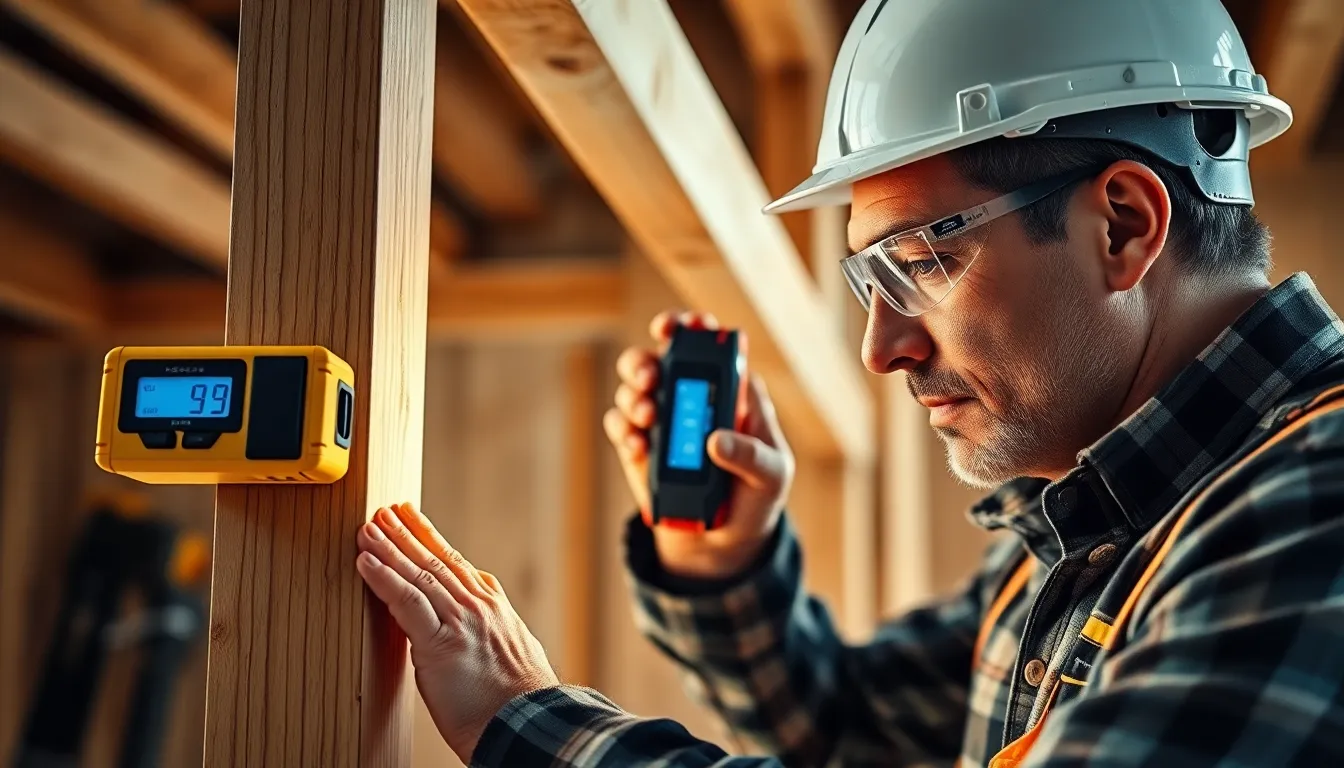Table of Contents
ToggleIn a world where precision is king, digital measuring tools have become the unsung heroes of accuracy. Gone are the days of squinting at tape measures or playing tug-of-war with a yardstick. With a simple press of a button, these gadgets can transform any measurement task from a frustrating chore into a walk in the park—or at least a stroll down the tool aisle.
Overview of Digital Measuring Tools
Digital measuring tools transform how individuals approach measurements, providing a level of precision that traditional tools cannot match. Various types exist, including laser distance meters, digital calipers, and electronic levels. Laser distance meters simplify the process of measuring long distances accurately, often providing measurements within millimeters.
Digital calipers are essential for obtaining precise dimensions on small objects, with readings easily viewable on LCD displays. Users appreciate the versatility of electronic levels, which offer a clear digital readout of angles, making them ideal for construction and installation tasks. These devices enhance user experience by eliminating human error often associated with analog tools.
Identifying features like Bluetooth connectivity stands out in many modern measuring tools. Such functionality enables syncing measurements directly to smartphones or tablets, streamlining project documentation and collaboration. Battery life also plays a critical role, with many advanced digital tools available with rechargeable options designed for extended use.
Utilizing these tools often saves time, enabling users to complete tasks more efficiently. Accuracy assures professionals that their measurements meet exact specifications, which is crucial in fields such as construction and engineering. The convenience of lightweight designs allows for easier portability, making them ideal for on-site applications.
Digital measuring tools represent a significant advancement over traditional equipment. Many users, particularly in demanding industries, find that adopting these tools leads to improved project outcomes and increased productivity. As technology continues to evolve, further innovations in this area strengthen the capabilities of digital measuring tools.
Types of Digital Measuring Tools

Digital measuring tools come in various forms, each designed to enhance accuracy and ease of use. Here are some prominent types:
Laser Distance Measurers
Laser distance measurers facilitate quick and accurate measurements over long distances. Equipped with laser technology, they can measure up to 300 feet or more without physical contact. Users appreciate features like memory functions that store multiple measurements. Some models connect via Bluetooth, allowing measurements to sync directly to smartphones or tablets. This functionality significantly improves workflow efficiency, particularly for construction and renovation projects.
Digital Calipers
Digital calipers allow for precise measurements of small objects, offering resolutions of up to 0.001 inches. They measure internal and external dimensions, as well as depths and steps. Many models come with an easy-to-read digital display that enhances visibility. Stainless steel construction provides durability, making them suitable for professional and home use. Their versatility makes them essential tools in various industries, including engineering and woodworking.
Digital Levels
Digital levels offer clear digital readouts for determining angles and flatness. They often feature audible indicators that signal when a surface is level. Some units provide additional features, such as memory settings that recall previous measurements. High-precision sensors ensure accurate readings, making them practical for carpentry and construction tasks. Their user-friendly design supports quick assessments in tight spaces and complex installations.
Benefits of Using Digital Measuring Tools
Digital measuring tools provide numerous advantages that enhance measuring tasks across various fields. Their contributions to accuracy and ease of use are particularly noteworthy.
Accuracy and Precision
Digital measuring tools excel in accuracy and precision, significantly surpassing traditional counterparts. Laser distance meters can measure distances exceeding 300 feet accurately, allowing for exact measurements over long spans. Digital calipers offer resolutions as precise as 0.001 inches, ensuring small objects are measured with utmost detail. Electronic levels display angle measurements clearly, reducing human error during tasks. Enhanced features like Bluetooth connectivity enable data syncing, improving efficiency. These features contribute to greater reliability in project outcomes.
Ease of Use
Ease of use characterizes digital measuring tools, making them accessible for various users. Digital calipers feature simple buttons and displays, allowing users to switch between measurement units effortlessly. Laser distance meters often come with one-button operations, simplifying the measurement process. Electronic levels provide audible feedback and memory functions, facilitating quick readings without recalibrating. Battery life in these tools often lasts for extended periods, minimizing interruptions during projects. This user-friendly approach improves productivity, making digital measuring tools ideal for both professionals and DIY enthusiasts.
Applications of Digital Measuring Tools
Digital measuring tools find extensive applications across various industries, enhancing precision and efficiency in measurement tasks.
Construction and Renovation
Construction professionals rely on digital measuring tools for accuracy in their projects. Laser distance meters determine the lengths of walls and spaces quickly, significantly speeding up planning phases. They enhance productivity by minimizing human error during measurements. Digital levels ensure surfaces are flat, a critical requirement for structural integrity. These tools simplify project management by providing instant readouts. Workers can check measurements from a distance, eliminating the need for multiple trips back and forth. With Bluetooth connectivity, data syncs seamlessly to planning software, streamlining communication among team members.
Carpentry and Woodworking
Carpenters utilize digital calipers for precise measurements of wood dimensions. Using these tools, accuracy reaches resolutions of up to 0.001 inches, essential for high-quality craftsmanship. They allow easy comparisons between different wood pieces, aiding in cutting and joining processes. Electronic levels support carpenters by confirming angles for joints and cuts. Additionally, audible indicators assist in ensuring the proper alignment of materials. Overall, digital measuring tools empower carpenters to deliver superior results in their projects, reducing waste and saving time.
Engineering and Design
Engineers and designers depend on digital measuring tools for detailed and precise modeling. Digital calipers measure small components, ensuring parts fit together seamlessly in assemblies. Laser distance meters offer accurate measurements over longer distances, crucial for site planning and layout design. Project specifications benefit from the accuracy of electronic levels, ensuring that structures meet design requirements. These tools facilitate collaboration, as measurements can be recorded and shared instantly among team members. Using these technologies enhances the design process, resulting in higher-quality outcomes in engineering projects.
Maintenance and Care for Digital Measuring Tools
Regular maintenance and care ensure digital measuring tools function optimally and last longer. Clean digital calipers with a soft cloth to remove dust and debris after every use. Store laser distance meters in protective cases to prevent damage when not in use. Inspect electronic levels regularly for any signs of wear or malfunction to maintain accuracy.
Batteries play a critical role in the performance of these tools. Replace batteries in a timely manner to prevent measurement inaccuracies due to low power. Optimal battery life typically ranges from several months to a couple of years, depending on usage frequency. Calibration should occur at least once a year to ensure precision. Users can refer to the manufacturer’s guidelines for specific calibration procedures.
Moisture can severely affect the functionality of digital measuring tools. Keep these tools away from wet environments to avoid corrosion and electrical issues. In cases where moisture exposure occurs, dry them thoroughly before attempting to power them on. Additionally, check for loose connections or faulty parts, especially if the tool experiences erratic behavior.
Taking these simple precautions enhances the durability and performance of digital measuring tools significantly. Engaging in routine maintenance not only saves costs associated with replacements but also enhances measurement accuracy. Employing proper care practices ensures that professionals and hobbyists achieve reliable results in their projects.
Digital measuring tools have transformed the way professionals approach accuracy and efficiency in their projects. By integrating advanced technology into measurement tasks these tools not only simplify the process but also significantly reduce the margin for error. Their versatility across various industries showcases their essential role in modern practices.
With proper maintenance and care users can ensure these tools remain reliable and effective. As digital measuring tools continue to evolve they’ll undoubtedly play an even more crucial role in enhancing productivity and precision across multiple fields. Embracing these innovations is key to achieving superior results in any measurement-related endeavor.










